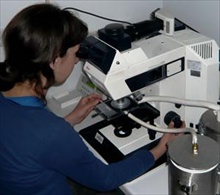Linkam temperature controlled cryo stage selected by the Leiden University Medical Center to study biological specimens
 Market leaders in temperature controlled microscopy,
Linkam Scientific Instruments announce the use of their THMS600 temperature
stage at the Leiden University Medical Center to aid the cryo-study of
biological specimens.
Market leaders in temperature controlled microscopy,
Linkam Scientific Instruments announce the use of their THMS600 temperature
stage at the Leiden University Medical Center to aid the cryo-study of
biological specimens.Professor A.J. Koster (Leiden University Medical Center) is one of the founders of NeCEN, the Netherlands Center of Electron Nanoscopy which was formed to advance cryo-TEM in the Netherlands by joining national groups in the realization of a national centre housing a number of high-end electron microscopes (www.necen.nl).
Professor Koster's own group focuses on applications in cell biology. His goal is to localize molecular structures in cells using fluorescence microscopy and then transfer the sample to a cryo-electron microscopy (Cryo-EM) set up to image the corresponding macromolecular structures in 3D with nm-scale resolution. Two areas are of particular interest: the study of viral infections and viral replication where fluorescence may be used to pinpoint areas worthy of enhanced investigation. The other is in the field of vascular biology to study the process of regulated exocytosis of Weibel-Palade bodies (WPBs) that is a pivotal mechanism via which vascular endothelial cells initiate repair in response to injury and inflammation.
The goal of the studies was to develop a setup and workflow for cryo-CLEM (correlative light and electron microscopy) that permits visualization of structures in cryo-FM (fluorescence microscopy) at sub-cellular resolution, and that retrieves those structures accurately in cryo-EM for the purpose of cryo electron tomography. The group wanted a cryo-FM setup that was easy to implement. To this end, Professor Koster and his colleagues opted for a commercially-available heating and freezing stage (the Linkam THMS 600), which was modified in order to accommodate EM support grids.
As Professor Koster says, "before we found the Linkam system in the literature and the ability to correlate microscopies, combining modalities was next to impossible. We have now been using this cryo-CLEM method for more than three years. It has certainly enabled us to produce results quickly and hence get to publication more rapidly too." (European Journal of Cell Biology 88 (2009) 669-684).
More than 3,000 THMS600 stages are in use in laboratories worldwide. It is used in many applications where high heating/freezing rates and 0.1°C accuracy and stability are needed. Samples can be quickly characterized by heating to within a few degrees of the required temperature at a rate of up to 150°C/min with no overshoot, then slowed down to a few tenths of a degrees per minute to closely examine sample changes.
Visit the Linkam website (www.linkam.co.uk) today and learn about the broad range of applications in the field of temperature controlled microscopy.
